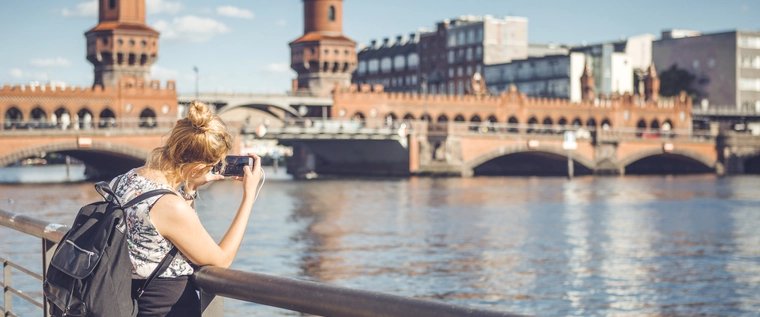
A 200-year architecture walk in Marzahn-Hellersdorf
On the eastern outskirts of the city you can walk through 200 years of architecture. From the Gründerzeit manor house, a turn-of-the-century swimming pool and a modernist poor people's settlement to the GDR panel buildings and post-reunification architecture.
Mahlsdorf Manor House: Start at the Gutshaus Mahlsdorf - a jewel of the Wilhelminian period in Berlin-Mahlsdorf. Built in 1815, the manor house today houses one of the most beautiful collections from the Wilhelminian period between 1870 and 1900 in Berlin.
Take a look around the 14 fully furnished exhibition rooms of the house: In an extraordinary unity they are equipped with furniture, cast-iron stoves and lamps up to laundry sets and monogram embroidery from the Wilhelminian period (1870-1900). With gentle ticking and strong gong the grandfather clocks go here and in the kitchen stands beside an original stove of the time even an icebox and many typical kitchen appliances. Watches, music automatons, music boxes and phonographs and gramophones have particularly impressed Charlotte, the trained curator. A walk through the picturesque manor park with its restored, historically curved paths will inspire you. And in the basement of the house a completely different ambience awaits you: Here you will find the last completely preserved Berlin pub from the Scheunenviertel - Charlotte rescues the "Mulackritze" during the demolition of the building in 1963 and re-installs the original in the cellar of the museum. Together with the Gutspark and the museum, the Gutshaus in Mahlsdorf - in the Berlin district of Marzahn-Hellersdorf - forms an ensemble worth seeing, in which residential and garden culture are combined in an exemplary manner.
Streusiedlung Mahlsdorf II
Bruno Taut is one of the founders of modern architecture. In Berlin in the 1920s and 1930s, he realized numerous social housing projects - including the famous horseshoe housing estate, which is on the UNSESCO World Heritage List. Between 1924 and 1931, two settlements were also built in the tranquil Mahlsdorf for the "Lichtenberger Gartenheim" cooperative. They were designed and built primarily for war-disabled people from the First World War and large families from Berlin. The small and therefore also inexpensive type houses on relatively large properties are characteristic. The largest contiguous listed area can be found in the Ferttchenweg. The exemplary renovation of the building at Ferttchenweg 29/31 shows particularly well the original shape, colours and furnishings of the houses. Wernerbad
Continuing northwards, you can discover one of Berlin's famous Hidden Places - the former Wernerbad. Earlier than its big sister at Wannsee, it is basically one of the oldest open-air swimming pools in the city. Opened at the beginning of the 20th century, the bathers splashed here for almost 100 years until it had to close in 2002 and has been decaying ever since. The former Wernerbad is located in the middle between Marzahn-Hellersdorf's prefabricated housing estates and single-family housing estates. While the area is being renaturalized to turn the former swimming pool back into a natural lake, the rest of the pool will probably be converted into a park. What remains are the works of the sculptor Erwin Kobbert. As the mascot of the Wernerbad, he created a small group of penguins and the famous hippopotamus Knautschke, which the Berliners love so much that it is even listed.
Haus Dittmar
Just a stone's throw away you can see overlapping cubes in warm red between the trees. They characterise the outer form of the listed residential building "Haus Dittmar" in Kaulsdorf. Its structure, inspired by the "Bauhaus", makes it look like a sculpture made of multi-coloured false-fired bricks. When Peter K. Bachmann and Ute Linz saw the night sky through the opened living room ceiling of their newly acquired house in November 2009, it was not to be expected that this "sculpture" would one day be called an "architectural jewel of modernity" by the State Monuments Office. From the point of view of architectural styles, this house should not exist. It was designed in 1932 by Edmund Dittmar for his father in a mixture of brick expressionism and modernism and was the only one of his buildings to remain unique. In 2016, the Berlin Senate honoured the project with the "Ferdinand-von-Quast Medal", the highest state award for monument preservation.
Hellersdorf - Large housing estate
Further north, the face of the surroundings changes abruptly. Behind private houses the prefabricated buildings of the district founded in 1986 rise abruptly.
From the mid-1980s onwards, Hellersdorf was built and even extended beyond the then immovable city limits of Berlin under the Four Powers Agreement. As Berlin's second largest construction project at the time, the Helle Mitte district centre was finally completed in 1997. It forms the centre of Hellersdorf.
Within the framework of the Berlin district reform, Hellersdorf lost its independence again in 2001 and the new district has since been called Marzahn-Hellersdorf.
.
.



